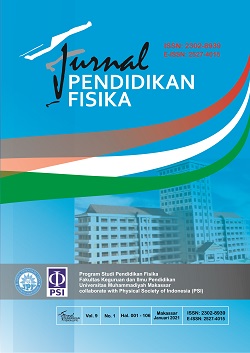Development of Physics Learning Media Based-Mobile Learning Using Adobe Flash CS6 at Muhammadiyah University of Makassar
DOI: https://doi.org/10.26618/jpf.v9i1.4651
adobe flash CS6, development, mobile learning, physics learning media
Abstract
This research is motivated by the fact that physics learning content based on mobile learning can be accessed widely and most students have cellphones, but it has not been widely used to increase student enthusiasm in learning physics. Physics Learning Media Based on Mobile Learning is an effort to solve this problem. One of them is by Development of Physics Learning Media-Based Mobile Learning Using Adobe Flash CS6. This study aimed to determine the development of learning media products based on mobile learning using adobe flash CS6 and to examine the the feasibility of learning media based on mobile learning using Adobe Flash CS6 at Muhammadiyah University of Makassar. This type of research was a research and development starting from the defining stage (define), the design stage (design), and the development stage (develop). This mobile learning-based physics learning media was tested for validity by 2 experts of media, and tested for its effectiveness by 33 students. The results achieved were the m-learning media products that used the adobe flash CS6 application with validity criteria that were relevant, consistent and have practical usability, as well as effective implementation. These instructional media products can be used by teaching staff and students in higher education. as well as effective implementation. These instructional media products can be used by teaching staff and students in higher education. as well as effective implementation. These instructional media products can be used by teaching staff and students in higher education.
References
Astuti, I. A. D., Sumarni, R. A., Saraswati, D. L. (2017). Development of android-based mobile learning physics learning media. Journal of Research and Development in Physics Education, 3(1), 57-62.
http://journal.unj.ac.id/unj/index.php/jpppf/article/view/2533/1948
Ashari, S., & Istiyanto, J. E. (2009). Perspectives & challenges of mobile learning development. Scientific Journal of Informatics, 5(1), 46-55. http://repository.maranatha.edu/337/1/Perspektif%20Tantangan%20Pengembangan%20M-Learning_luar.pdf
Bonaditya. (2014). Introduction to adobe flash CS6. Retrieved from https://id.wikipedia.org/wiki/AdobeFlash
Bustomi, A. Y. (2010). Human senses learning application based on android. Journal of Telematics, 3(1), 25-30. https://ejournal.amikompurwokerto.ac.id/index.php/telematika/article/view/195
Estianinur. (2017). Mobile learning application development using adobe flash professional CS6 based android on the characteristics of mechanical waves for class XI SMA. Journal of Physics Education, 2(2), 1-11. https://onlinejournal.unja.ac.id /EDP/article/view/4054/8541
Fatimah, S., & Mufti, Y. (2014). Development of learning media for android-based smartphone science-physics as strengthening student character. Kaunia's Journal, 10(1), 59-64. http://ejournal.uinsuka.ac.id/saintek/kaunia/article/view/1066
Gikas, J., & Grant, M. M (2013). Mobile computing devices in higher education: Student perspectives on learning with cellphones, smartphones & social media. Journal of Internet and Higher Education, 19 (2), 18-26.
https://daneshyari.com/ article/preview/357763.pdf
Hanafi, H. F., & Samsudin, K. (2012). Mobile Learn¬ing Environment System (MLES): The case of android-based learning application on un¬dergraduates learning. International Journal of Advanced Computer Science and Applications, 3(3), 1-5. https://arxiv.org/ftp/arxiv/papers/1204/1204.1839.pdf
Ishaq. (2013). Design of learning development based on information and communication technology (ICT) in computer application courses. Jurnal Pendidikan Fisika, 1(1), 73-85. https://journal.unismuh.ac.id/index.php/jpf/article/view/191/178
Mcconatha, D., Praul, M., Lynch, M. J. (2008). Mobile learning in higher education: an empirical assessment of a new educational tool. Turk¬ish Online Journal of Educational Technology. 7(3), 223-244.
https://files.eric.ed.gov/fulltext/EJ1102943.pdf
Nurwahid, S. (2017). Development of web-based science learning tutorial media for class VIII SMPN 5 Pallangga students. Jurnal Pendidikan Fisika 5(2), 156-174.
https://journal.unismuh.ac.id/index.php/jpf/article/view/621/667
Sarrab, M., Elgamel, L., Aldabbas, H. (2012). Mo¬bile learning (M-Learning) and educational environments. International Journal of Distrib¬uted and Parallel Systems (IJDPS), 3(4), 31-38.
Tamhane, K.D, et al. (2015). Mobile learning application. International Journal of Scientific and Research Publications, 5(3), 1-4.
http://www.ijsrp.org/research-paper-0315/ijsrp-p39128.pdf
Zhaohua, Z., Cheng, J., Peng, J. (2015). Design and implementation of teaching system for mo-bile cross-platform. International Journal of Multimedia and Ubiquitous Engineering, 10(2), 287-296. https://www.researchgate.net/publication/283445029_Design_and_Implementation_of_Teaching_System_for_Mobile_Cross-platform
Trianto. (2007). Integrated Learning Model in Theory and Practice. Jakarta: Prestasi Pustaka Publisher.
Downloads
Published
How to Cite
Issue
Section
License
Copyright:
Authors who publish with this journal agree to the following terms:
1. Authors retain copyright and grant the journal right of first publication with the work simultaneously licensed under a Creative Commons Attribution-ShareAlike 4.0 International License that allows others to share the work with an acknowledgement of the work's authorship and initial publication in this journal.
2. Authors are able to enter into separate, additional contractual arrangements for the non-exclusive distribution of the journal's published version of the work (e.g., post it to an institutional repository or publish it in a book), with an acknowledgement of its initial publication in this journal.
3. Authors are permitted and encouraged to post their work online (e.g., in institutional repositories or on their website) prior to and during the submission process, as it can lead to productive exchanges, as well as earlier and greater citation of published work.
Licence:
Authors are free to:
1. Share: Copy and redistribute the material in any medium or format
2. Adapt: Remix, transform, and build upon the material for any purpose, even commercially.
The licensor cannot revoke these freedoms as long as the authors follow the license terms, which include the following:
1. Attribution: You must give appropriate credit, provide a link to the license, and indicate if changes were made. You may do so in any reasonable manner, but not in any way that suggests the licensor endorses you or your use.
2. ShareAlike: If you remix, transform, or build upon the material, you must distribute your contributions under the same license as the original.
3. No additional restrictions: You may not apply legal terms or technological measures that legally restrict others from doing anything the license permits.
Jurnal Pendidikan Fisika is licensed under a Creative Commons Attribution-ShareAlike 4.0 International License.






